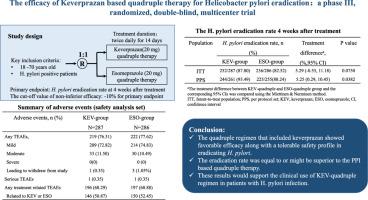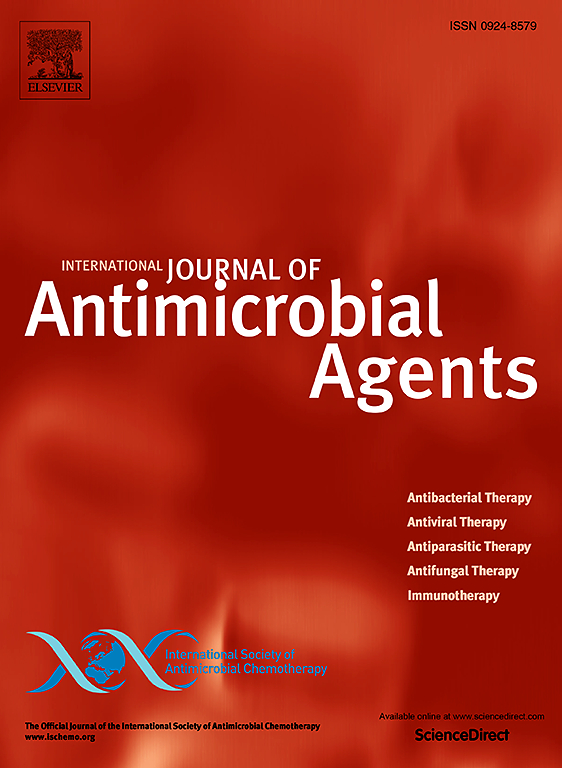The efficacy of keverprazan-based quadruple therapy for Helicobacter pylori eradication: a phase III, randomised, double-blind, multicentre trial
IF 4.9
2区 医学
Q1 INFECTIOUS DISEASES
International Journal of Antimicrobial Agents
Pub Date : 2024-09-16
DOI:10.1016/j.ijantimicag.2024.107320
引用次数: 0
Abstract
Introduction
Keverprazan is a novel potassium-competitive acid blocker. The advantages of keverprazan as a potent acid suppressor in Helicobacter pylori eradication have not yet been demonstrated. The aim of this study was to evaluate the efficacy of keverprazan as a component of bismuth quadruple therapy in H. pylori treatment.
Methods
Adult patients with H. pylori infection were enrolled and randomised to take keverprazan (KEV group)- or esomeprazole (ESO group)-quadruple therapy. The regimens contained keverprazan 20 mg or esomeprazole 20 mg, clarithromycin 500 mg, amoxicillin 1000 mg and bismuth potassium citrate 240 mg and were administered twice daily for 14 days. The primary endpoint was the H. pylori eradication rate at 4 weeks after treatment.
Results
The full analysis set showed that the H. pylori eradication rates were 87.8% (252/287) and 82.52% (236/286) for the KEV and ESO groups, respectively (difference: 5.29%; 95% confidence interval [CI]: -0.55–11.18). Keverprazan was superior to esomeprazole in terms of eradication rate in the per protocol set (P=0.0382). The eradication rates for patients resistant or non-resistant to clarithromycin were both numerically higher in the KEV group than the ESO group (83.45% vs. 76.98% for clarithromycin-resistance; 92.31% vs. 88.16% for clarithromycin-non-resistance). The incidence of adverse events was similar in the KEV and ESO groups (76.31% vs. 77.62%), with most adverse events (>90%) being mild in severity. No TEAEs led to death in either group.
Conclusions
Keverprazan 20 mg twice daily, used as a component of bismuth quadruple therapy, provided effective H. pylori eradication and was non-inferior to an esomeprazole-based regimen.

基于开瑞坦的根除幽门螺旋杆菌四联疗法的疗效:一项 III 期随机、双盲、多中心试验。
简介Keverprazan是一种新型钾竞争性酸阻滞剂,其作为强效酸抑制剂根除幽门螺旋杆菌(H. pylori)的优势尚未得到证实。本研究旨在评估 Keverprazan 作为四联铋剂治疗幽门螺杆菌的疗效:成年幽门螺杆菌感染患者入组并随机接受开瑞普拉赞(KEV组)或埃索美拉唑(ESO组)-四联疗法(治疗方案包括开瑞普拉赞20毫克或埃索美拉唑20毫克、克拉霉素500毫克、阿莫西林1000毫克、枸橼酸铋钾240毫克),每日两次,共14天。主要终点是治疗后 4 周的幽门螺杆菌根除率:全套分析结果显示,KEV 组和 ESO 组的幽门螺杆菌根除率分别为 87.8%(252/287)和 82.52%(236/286)(差异:5.29%;95% CI:-0.55% 至 11.18%)。就根除率而言,按方案组观察到开维普拉赞优于埃索美拉唑(P=0.0382)。KEV组对克拉霉素耐药或不耐药患者的根除率均高于ESO组(克拉霉素耐药患者的根除率为83.45%,ESO组为76.98%;克拉霉素不耐药患者的根除率为96.67%,ESO组为93.38%)。KEV组和ESO组的不良反应发生率相似(76.31% vs. 77.62%),大多数不良反应(>90%)的严重程度较轻,没有导致死亡:结论:Keverprazan 20 毫克,每日两次,作为铋剂四联疗法的一部分,可有效根除幽门螺杆菌,其疗效不劣于以埃索美拉唑为基础的治疗方案。
本文章由计算机程序翻译,如有差异,请以英文原文为准。
求助全文
约1分钟内获得全文
求助全文
来源期刊
CiteScore
21.60
自引率
0.90%
发文量
176
审稿时长
36 days
期刊介绍:
The International Journal of Antimicrobial Agents is a peer-reviewed publication offering comprehensive and current reference information on the physical, pharmacological, in vitro, and clinical properties of individual antimicrobial agents, covering antiviral, antiparasitic, antibacterial, and antifungal agents. The journal not only communicates new trends and developments through authoritative review articles but also addresses the critical issue of antimicrobial resistance, both in hospital and community settings. Published content includes solicited reviews by leading experts and high-quality original research papers in the specified fields.

 求助内容:
求助内容: 应助结果提醒方式:
应助结果提醒方式:


